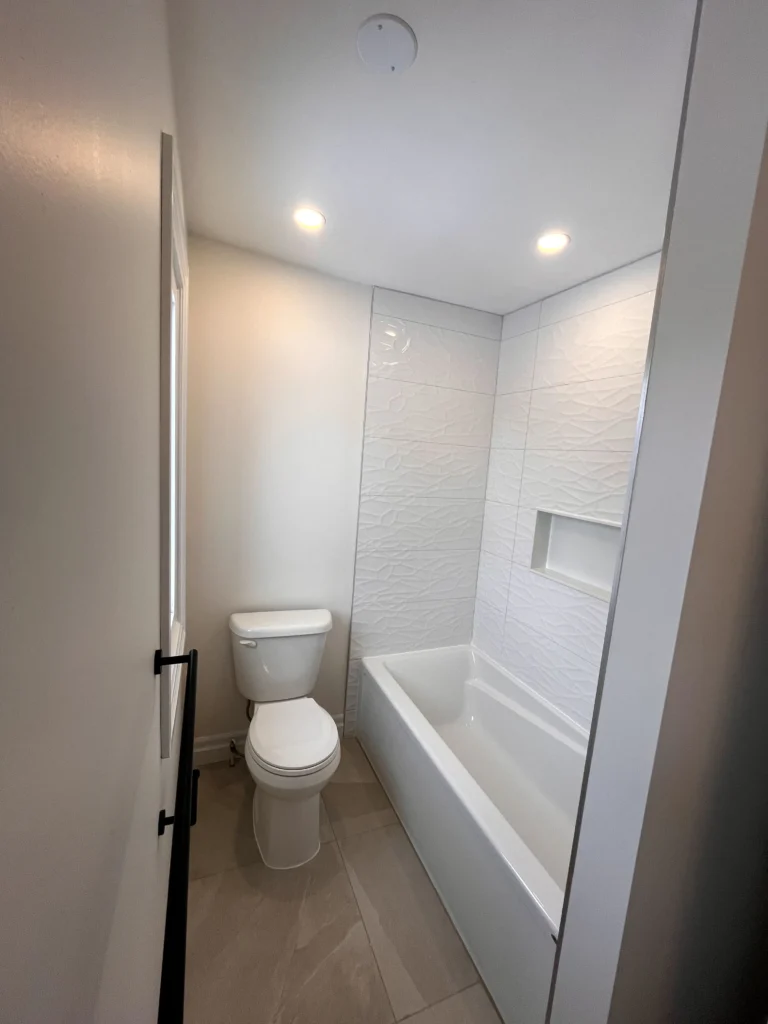Thinking about remodeling your bathroom? In this article, I’ll walk you through how to properly plan your renovation—from layout and budgeting to material selection and timing—so you avoid the most common mistakes homeowners make.
Where Bathroom Renovation Planning Really Starts
When someone comes to me with a bathroom renovation idea, the very first thing I ask is why they’re renovating. Are they tired of how it looks? Is something broken? Are they preparing to sell the house or stay for 10 more years?
That “why” determines everything—from the budget to the layout. Then, I look at what they’re working with: the space, how many pieces (tub, shower, toilet, vanity), and whether they want to keep the layout or do something more ambitious. The goals drive the design. If you don’t know what you’re trying to achieve, it’s easy to get overwhelmed or waste money.
Mistakes People Make When They Skip the Planning Phase
I’ve seen homeowners rush to buy tiles because they were on sale, only to realize later that the color doesn’t match their vanity—or worse, they didn’t buy enough. Others hire a contractor before deciding on layout or measurements, which causes delays and rework.
One time, a client bought a bathtub before checking if it fit through their hallway. Spoiler: it didn’t. We had to send it back. That’s time and money wasted. If you’re unsure what goes first, read my article on Can You DIY Your Bathroom Renovation? to better understand the risks of planning backward.
Budgeting: Be Realistic, and Don’t Forget the Hidden Costs
When setting your budget, always ask yourself: am I planning just for the visible finishes, or the entire scope of the work?
A big hidden cost is prep work. If your floor or walls are crooked or soft, they must be fixed first. Plumbing and electrical updates, floor leveling, waterproofing, and demolition all add up. You don’t want to skip these because they’re what make the new materials last.
At Raakss Reno, our pricing is all-inclusive from start to finish—gutting to completion—but does not include the construction materials like vanities or tiles. For a detailed breakdown, read our post on Average Bathroom Renovation Cost in Toronto and Budget Tips for 2025.
Choosing the Right Layout for Your Space
You can’t just copy a Pinterest photo and expect it to work in your space. Small or oddly shaped bathrooms need custom planning. In tight spaces, we might use a wall-mounted toilet or floating vanity to give the illusion of more room.
Some clients want a double vanity in a small bathroom—but if it cramps the space and limits walking room, it’s not worth it. I always prioritize flow and function first, beauty second. Check out some ensuite bathroom ideas for more layout inspiration.
Splurge vs Save: Where to Invest Your Money
If I had to pick where to splurge, it’s usually the vanity and the glass. Those two things are focal points, and you’ll use them every day. A high-quality vanity with great storage and soft-close drawers makes a huge difference.
Glass? Go frameless and thick—it’s stronger, more modern, and doesn’t wobble like the cheap kits. If you’re trying to save, consider more affordable tile options or a standard acrylic shower base over a custom tile base.
I also recommend reading our guide on How to Choose Bathroom Glass and Mirrors to avoid missteps.
How Long Does a Bathroom Renovation Take?
From first consult to final walkthrough, it can take anywhere from 3 to 8 weeks, depending on your timeline and how prepared you are.
Typical stages:
-
Initial consultation and quote (1–2 weeks)
-
Design and material decisions (1–2 weeks)
-
Demo and prep (2–3 days)
-
Plumbing, electrical, framing (2–4 days)
-
Tiling and finishing (1–2 weeks)
-
Final walkthrough and touch-ups (1–2 days)
Delays often come from backordered items, late decisions, or waiting for permits. The more you prepare in advance, the smoother it goes.
Should You Buy Materials First or Hire a Contractor?
Always bring a contractor in first—ideally someone like myself who can walk you through what materials make sense for your layout, plumbing, and long-term use.
Buying everything before knowing how it all fits can lead to expensive mistakes. The contractor should guide you on measurements, load-bearing concerns, and compatibility before you buy anything.
If you’re worried about the process or choosing the wrong person, check out our guide on What to Ask Before Hiring a Bathroom Renovation Contractor.
Tub, Walk-In Shower, or Wet Room?
This decision comes down to lifestyle.
-
Families with young kids or pets? You need at least one bathtub in the home.
-
Busy professionals? Walk-in showers are quicker and easier to clean.
-
Mobility issues or aging-in-place? Curbless walk-in showers with grab bars are a game changer.
One of my most popular renovations involves converting a tub into a walk-in shower using pre-built kits. They’re modern, efficient, and less prone to water damage over time.
What to Prepare Before Meeting a Contractor
You don’t need architectural drawings, but here’s what helps:
-
Photos of your current bathroom
-
Measurements (length, width, height)
-
A list of features you want (i.e. double sink, walk-in shower, etc.)
-
Inspirational photos to share your vision
-
A rough idea of your budget
This saves time and helps me create a quote that actually reflects what you want.
Planning Ahead: 3–6 Months Out
If you’re thinking ahead, great! Here’s what to start doing now:
-
Research contractors and read reviews
-
Save examples of styles you like
-
Visit showrooms to get a feel for materials
-
Get rough quotes for materials
-
Apply for permits if you’re doing a major reno
You can also try our quote estimation tool to get a sense of your budget.
Final Thoughts
Planning a bathroom renovation doesn’t have to be stressful—if you plan it properly. Prioritize your goals, budget smartly, and don’t rush decisions. I’m Robbie Fraikin from Raakss Reno, and if you’re looking for someone to walk you through it all—from layout to final detail—I’m here to help. If you want to see more of our bathroom renovation services, click here.
Check out more of our bathroom renovation blogs or contact me directly to start your project today.
2. Bad Tiling and Improper Floor Prep
I can’t tell you how many times I’ve walked into a bathroom with cracked grout, popping tiles, or soft flooring underneath tile installs. Most of the time, it’s because the contractor tiled over subfloor that was too thin or didn’t reinforce it properly. In some cases, they skipped using mesh, didn’t use mortar, or used adhesive where tile mortar should’ve been used.
One time, we had to redo a full bathroom floor where the tile was laid over quarter-inch plywood with no mortar mesh underneath. The floor flexed, grout cracked, and tiles shifted. The homeowner had to pay twice for the job—once to do it wrong, then again for us to do it right.
The fix: We properly evaluate subfloor thickness, reinforce if needed, and use tile mortar with mesh (or systems like Schluter Ditra). These aren’t fancy upgrades—they’re the minimum standard.
📚 Here’s some other articles we talked about:
3. Sloppy Electrical & Plumbing Work
This one is not just inconvenient—it’s dangerous. We’ve opened up walls to find live wires exposed, ungrounded outlets near water, and DIY-level plumbing that wasn’t sealed properly. We even found a faucet connected with rubber tubing that burst after just a few weeks.
A client once hired us after their first contractor installed a toilet that wasn’t connected to the drain properly. It led to water leaking underneath the tiled floor, creating mold that spread under the vanity and baseboards. They had to gut the whole thing—and their trust was broken.
Why this happens: Some contractors sub out to unqualified trades or rush the job with whoever’s available. Others try to cut corners.
The fix: We never cut corners. Our in-house team handles every trade properly—from licensed electricians to certified plumbers. And if you’ve had a bad job done before, we’ll take the time to inspect every connection before we rebuild.
📚 Related:
Why Does This Happen So Often?
In short, it’s a mix of inexperience, rushing, and cutting corners to win a bid. Contractors who underbid jobs end up scrambling to finish quickly or hiring cheap labor to make a profit. In the end, it’s the homeowner who pays—sometimes twice.
Dangerous mistakes like improper waterproofing or exposed electrical work need urgent repair. These aren’t just cosmetic issues; they can lead to mold, fire hazards, or severe property damage.
The Emotional & Financial Toll of a Bad Reno
I’ve seen homeowners break down in frustration after trusting someone who didn’t deliver. It’s not just money—it’s time lost, stress added, and having to live in a construction zone all over again.
A bad reno job isn’t just expensive to fix—it’s emotionally draining. And for many, it kills the excitement of improving their home.
How We Spot and Fix Other Contractor’s Mistakes
When we’re called in to fix someone else’s mess, we start with a detailed inspection—we look at walls, floors, plumbing, and electrical to figure out what’s safe and what needs to go. We rebuild from the foundation up, using the right materials for long-term reliability.
We also walk you through every step so you know what’s happening, why it failed before, and how we’re going to make sure it doesn’t happen again.
Need help now? Contact Raakss Reno for a consultation.
How to Spot Poor Workmanship Early
Here’s what to look out for:
-
Sloppy grout lines or uneven tile
-
Water pooling near fixtures
-
Exposed wires or mismatched switches
-
Materials that feel “soft” or bouncy
-
Quotes that are too vague or too low
If your contractor isn’t asking questions, that’s a red flag. Communication is everything.
Are Budget Renos More Prone to Problems?
Not always—but the cheapest quote is usually a sign that something’s being skipped. You don’t need the most expensive team, but you need someone who prices the job fairly and transparently.
Want to learn more? Read our article on cheap vs. value quotes to avoid falling for a sketchy offer.
My Message to Anyone Burned by a Renovation
If you’ve had a bad experience, I get it. It’s hard to trust again. But when you work with someone who listens, communicates, and backs up their work—it makes all the difference.
We’re not just here to renovate your bathroom—we’re here to restore your confidence in the process.
Explore More

